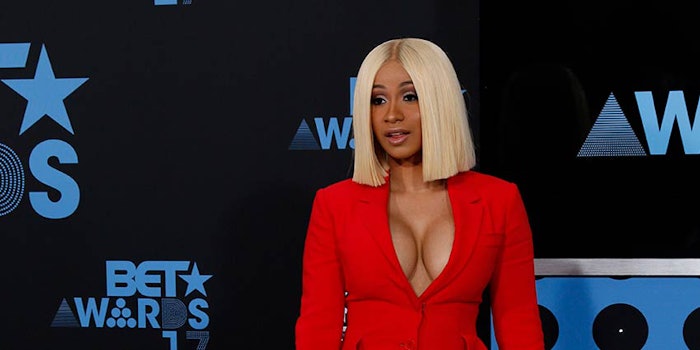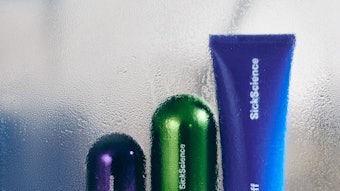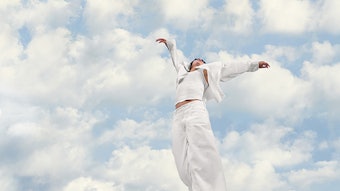
When I consulted in the launch for Avlon Industries’ breakthrough, oil-based lightener MoisturColor, in 2004, it was positioned as the first lightener safe and suitable for all hair textures—especially for blonding and highlighting African American hair.
At that time, my client’s major concern was whether or not the product would be accepted by white hairstylists as well. Surprise, that wasn’t the initial sales hurdle! Instead, it was feedback from some black hairstylists who felt no dark-skinned woman should ever wear a high-lift blonde shade like the model we presented on the sample lightener box kit.
“Some black women have natural ash or ashy colored hair tones, which means you can reach platinum blonde much easier and faster than with someone who has typically gold or red in their hair.”
I made this recommendation to the client to underscore the safety feature of this lightener for blonding, streaking and highlighting relaxed hair with minimal damage (if used according to manufacturer’s directions). That notion was dispelled, beginning in the 2000s, by early celebrity influencers such as Beyoncé and Mariah Carey, especially brown-skinned women like Lil’ Kim and Mary J. Blige, and wig-wearing RuPaul, all of whom presented the whole range of blonde hair shades.
Today’s Blonding Trends
“Color continues to play an important part in styles … with 65% plus of our readers using hair color to enhance their look,” Jocelyn Amador, editor of Sophisticate’s Black Hair magazine.
With more than 900,0000 followers on Facebook, Amador is an authority on the dominating salon- and retail-driven hairstyling and product trends for black women, consumer consumption, and major celebrity, blogger and street influencers.
Amador says that blonde hair in almost any shade has become a major trend across the ethnic hairstyle spectrum, from chemically treated hair (relaxers or keratin straightening treatments), to hair weaves/extensions and braids (the number-two category) to the fast-growing natural hair category (popular with black females aged 16 to 30) to the emerging trend of wearing human hair in front-lace wigs.
The Celebrity Factor
Beyoncé still reigns as the leading celebrity influencer, according to Jackie Challenger, colorist director for Hair Rules, one of the hottest Manhattan salons specializing in multicultural hair. Challenger, a color specialist more than 10 years, built up a portfolio under mentors Ted Gibson, Beth Minardi and Devachan. When not in the salon, she’s booked for editorial shoots, or pre-production at New York’s hottest fashion shows.
She’s seen an uptick in black female clients presenting photos of a wider array of blonde shades when they come in for a consultation. “Because of celebrities like Beyoncé, they now want the beigey, ashy blonde shades and more natural blonde tones,” says Challenger.”
Evolving Client Requests
She adds that many clients request blonde, sun-kissed hair, which means a colorist doesn’t have to place highlights near the root; this really helps protect black hair to lessen damage.
According to Challenger, she doesn’t get a lot of black female clients under 45 who are wearing relaxers because the preferred straightening process in NYC are the keratin chemical treatments. Lightening hair that has received a keratin treatment, she adds, is far less damaging than blonding relaxed hair, making it much easier to highlight and blonde hair. This type of treatment has also added to the increase in black blondes.
Redefining Blonde
For more than 35 years, former salon owner Leigh Jones (Ambra Salon, Chicago) has been a leading master colorist with a clientele that includes all races. He has worked as an editorial stylist/colorist, is a trade show educator and a past Clairol presidential board member.
“African-American women bought into the Clairol brand story that blondes have more fun just like everyone else,” says Jones.
Jones finds that among his greying, relaxed hair clients over age 45, the blonde shades are not only appealing, but frequently requested.
He adds that “35 years ago it was much harder” to accomplish the dazzling array of blonde shades on the many hair textures among black women, which are just as varied skin shades. Today, more black women want to go beyond a gold blonde.
“That’s where the danger comes from,” says Jones. “Some black women have natural ash or ashy colored hair tones, which means you can reach platinum blonde much easier and faster than with someone who has typically gold or red in their hair.”
With many black women under 30 opting for natural textured hair styles, Jones has seen more requests for platinum hair. However, that hasn’t stopped women with relaxed hair wanting some of that bold action as well, because, Jones adds, high-lift blonde hair “looks good on just about everybody.”
Manufacturers and advertising agencies appear to believe that natural hairstyles compose the biggest percentage in terms of hairstyle categories, and so these styles are often overrepresented by models in TV ads.
Jones finds that among his greying, relaxed hair clients over age 45, the blonde shades are not only appealing, but frequently requested.
Because black women have such a diversity of skin tones, from light to dark ebony, Jones says the blonde color gambit is wide open, including beige/pastel blondes, rose gold, coral blonde, platinum, red gold and more.
“It’s just a full exciting feast of blonde shades that black women are craving,” Jones says, “and black colorists/stylists have to be able to deliver. The real point is this: can you get the blonde shade safely?”
Blonding for Hair Weaves and Wigs
But there is one major trend that many professional manufacturers are overlooking that colorists like Challenger and Jones and African American hair weavers and custom wig makers are doing: blonding brown human hair for the hair weave/wig client.
Manufacturers and advertising agencies appear to believe that natural hairstyles compose the biggest percentage in terms of hairstyle categories, and so these styles are often overrepresented by models in TV ads. However, weaves/extensions and braids using human hair is more sought after by black clients: it’s considered to be a status symbol, be it full hair weaves, partial or braids.
“In regard to African-American blondes, it’s very important to blonde the hair yourself because there are so many different shades and tones of blonde that it’s really hard to get a store-bought blonde to match what you would bring the hair up to in order to look natural.”
Darnell Davis, owner of the Wig & Weft Collection by DDavis in Los Angeles, has a celebrity clientele that includes Beyoncé, Taraji P. Henson, Halle Berry, Ryan Destiny from the Fox TV show Star, and Erica Campbell, a Grammy, urban contemporary gospel/R&B singer. His clientele also includes professional black women who can afford blonde European or Brazilian hair for their weaves, wigs or braids.
Davis says that the average black beautician will purchase European or Brazilian human hair/wefts and dye the hair to blonde themselves in order to contain fees to service their clients.
“It’s not like you are finding a lot of women chopping off their natural blonde hair to sell.”
Davis notes, “In regard to African-American blondes, it’s very important to blonde the hair yourself because there are so many different shades and tones of blonde that it’s really hard to get a store-bought blonde to match what you would bring the hair up to in order to look natural.”
Challenger agrees. She gets a lot of requests to color human hair for weaves from her colleagues because, “It’s not like you are finding a lot of women chopping off their natural blonde hair to sell.”
The purchased hair, she says, “is usually manipulated, and when they do that, it’s coated, and it makes it hard for us to tone.”
For instance, she said, “It may be too gold and you want it ashy, so you might use bleach to remove it to rid the coating that seals the cuticle and that could affect the integrity of the hair.”
Davis feels it’s critical for anybody doing this to consider hair integrity, understand how to tone the hair and avoid the orange tint that can emerge from poorly treated hair. For these reasons Challenger usually asks the hairstylist performing the weave service at her salon to get 100% virgin hair. This makes it easier for her to blonde it, she explained.
More education support on lightening products and blonding African American hair is still needed.
Davis notes that blonde color trends for black women at first were about contrast. This has changed.
“In this season right now, we are seeing hair as being less of an accessory, so the colors aren’t as blonde,” he says. “However, we’re still working with contrast, but it’s more about finding the right tone and maybe creating shadow at the root that’s really important because it helps the look appear more natural.”
The Education Gap
Davis says the reason that “black stylists were stuck in the era of gold blondes for so long is because we were not fully educated in the color wheel, color tones and so forth.” He adds that this accounts for why the honey blonde shade remained such a popular color.
Cliff Vmir is a hair weaver for celebrity clients like the hottest trending celebrity influencer, rapper Cardi B, hip-hop artists like Trina and Spice, and R&B singer and actress Lil Mo, has been candid that hair weavers aren’t taken seriously by professional color and lightener companies, which therefore aren’t “concerned about coloring education for hair weavers.”
More education support on lightening products and blonding African American hair is still needed, Davis said, because otherwise it limits the black professional in offering the variety of shades that black women are demanding today.
Often, a client can have more than one texture on their head.
Vmir, whose company Hym Hair is based in Atlanta, concurs; he feels that teaching the average black stylist/weaver a more comprehensive understanding of the lightening chart and coloring hair in general would help them avoid leaving hair in “brittle, dry or ashy condition.”
Learning how lightening affects African American hair textures, Jones stressed, is also important: often a client can have more than one texture on their head. He also wants companies to promote and develop more strengthening conditioners. Jones feels this is another critical key to achieving the blonde shades that could only be worn by white women in the past. Jones prefers oil-based lighteners for black hair, like those from Avlon and Wella.
Challenger also uses Wella’s Olaplex for her relaxed clients, which she feels is mandatory to add to their service in order to protect their hair. But like Jones she has also used lightening products from L’Oréal, Redken and Schwarzkopf.
Leslie Honore ([email protected]), mentored by the esteemed, late African-American salon/retail marketer Walter Leaphart, is a consultant, with 30 years of experience in strategic marketing/branding, advertising and promotions aimed at the African-American and Hispanic salon/retail market.










